By Tyler Rossi for CoinWeek …..
Starting in 1964, the Paris Mint began producing a new series of special mint sets with very limited mintages. Marketed as Fleur De Coin (FDC), these sets contained between seven and 10 proof-like coins. Described on the internal information card included in all sets as “numismatic specimens” of the current circulation coins produced by the Paris Mint, these FDC sets are quite special.
While not used in modern US numismatics, the term Fleur De Coin is quite common in Europe. Used to designate the highest grade available to a coin, FDC is equivalent to MS 68-70 on the Sheldon grading scale. Directly translated as “flower of the die”, FDC coins must be either perfect or nearly so, display no distracting marks, have full luster, and a high level of eye appeal. This means that even toning must be visually appealing. Basically, the coin must be flawless to earn a FDC grade.
In a process similar to that used to produce Proof coins, the Paris Mint struck each piece individually with freshly polished dies using specially prepared planchets. Only then can they assure each piece to be truly FDC.

For the inaugural issuance in 1964, some 25,600 FDC sets were released, each containing seven denominations: 1 Centime (1.65 gr, 15.0 mm, Stainless Steel), 5 Centimes (3.5 gr, 19.0 mm, Chrome-Steel), 10 Centimes (3.0 gr, 20.0 mm, Aluminum-Bronze), 20 Centimes (4.0 gr, 23.5 mm Aluminum-Bronze), 50 Centimes (7.0 gr, 25.0 mm, Aluminum-Bronze), 1 Franc (6.0 gr, 24.0 mm, Nickel), and 5 Francs (12.0 gr, 29.0 mm, .835 silver).
On their obverse, the 1- and 5-Centime coins depict an ear of wheat, with two asymmetrical leaves, that is ringed by the cursive legend reading République Française. The larger 10-, 20-, and 50-Centime coins all show a dressed bust of Marianne with long flowing hair escaping from under a Phrygian cap. The 1- and 5-Franc coins both show a personification of Liberty called La Semeuse, known in English as “The Sower”.
The 1964 sets were packaged in long rectangular PVC flips labeled MONNAIE DE PARIS, MADE IN FRANCE, with a slot for each coin all in one row. The flips were then placed in grey cardboard boxes for sale. On the left-hand side of the box top is a set of blue, white, and red stripes to represent the French flag. The packaging also included a gold foil seal of the Monnaie de Paris and was labeled as “Exemplaires Numismatiques – Made in France’.
Paris also struck a combined FDC Mint Set in 1965 for French Somaliland and the French Polynesian colonies. The sets, which were originally sold for $4.50, included two polyester sleeves with four coins from Polynesia and five from Somaliland. Besides a note stating the colony names, the packaging mirrored the French 1965 set. With only 1,898 sets sold publicly, these are quite rare today.
The next year (1965), while the number of coins included in the set remained consistent, several of the denominations were changed.
The 5 Centimes was removed, the 50 Centimes was replaced with the nickel ½ Franc, and a large silver 10 Francs (25.1g, 37mm) was added. Engraved based on Augustin Dupré’s historic design, the 10-Francs coin depicts Hercules wearing a lion skin loin cloth while uniting the figures of Liberty and Equality. All 35,000 of the 1965 sets were packaged in the same manner as in 1964, and it wouldn’t be until 1973 that mintage figures would be as high.
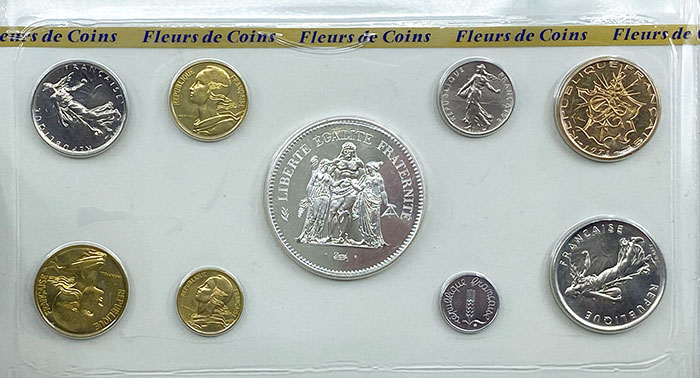
Sets released in 1966 were comprised of eight coins, since the 5 Centimes was included once again. The three years of 1966, ‘67, and ’68 represent the lowest mintages of the series with 7,171, 2,305, and 6,000 sets released, respectively. In 1968, a set originally cost $10 ($85.11 adjusting for inflation) and was packaged in a square box for the first time. The coins were also now heat sealed in a plastic sheet, like then-contemporary United States Mint sets. In 1968, collectors were also able to purchase the set without a box (only the blister pack of coins) for the first and only time. Despite these minor packaging changes, the number and type of coins was consistent until 1974.
In 1971, the Paris Mint accepted orders for the FDC sets until September 30, and collectors located in the US were required to send a certified check, money order, or postal transfer to the Paris Mint to cover the sales price of $7 plus a $2 fee. The mintage then shot up from 15,000 in 1972 to 79,000 in 1973 and would peak in 1974 when the Mint released 98,800 sets. For 1974, the 10-Francs coin was changed from silver to a nickel-brass alloy and a large new silver 50-Francs coin was added.
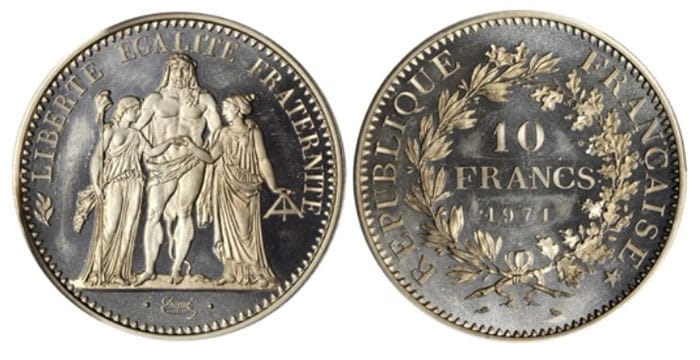
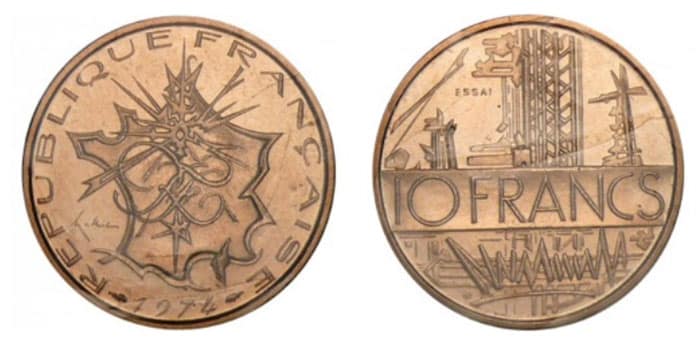
This new 10-Francs design, created by the French artist Georges Mathieu, depicts a stylized map of France on the obverse and high-tension towers with electric transmission wires on the reverse to symbolize France as a modernizing country. Meanwhile, the old 10-Francs design was shifted to the new 50-Francs coin.
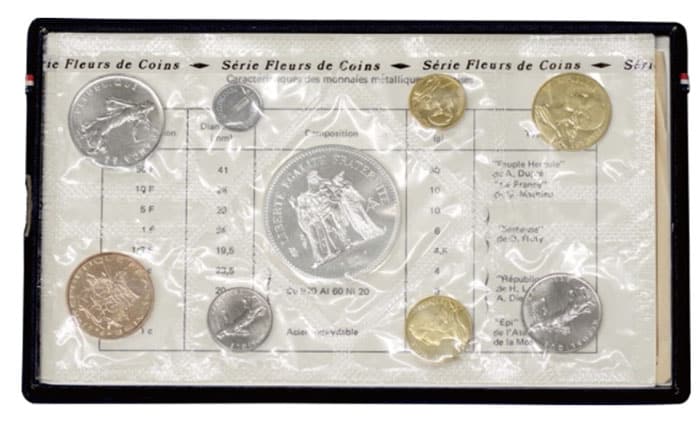
As reported by the New York Times in 1977, the sale price of the set was increased to $38 (including a $2 shipping fee) from $37 the prior year. The sets were also available in silver for $352 and in gold for $3,265. These specie sets are extremely rare. One 1977 gold FDC set sold by Heritage Auctions in 2016 hammered for roughly $20,000.
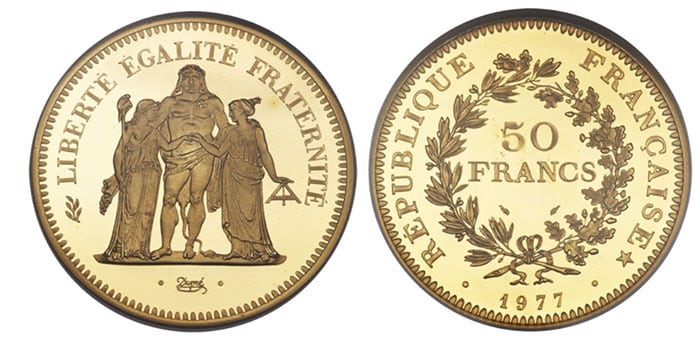
With the mintage dropping down to 25,000 and then 24,000 for sets in 1977 and 1978, respectively, these later sets are slightly more difficult to acquire than those of the early 1970s. Later, in 1979, the 2-Francs coin was added, making the FDC set a 10-coin set.
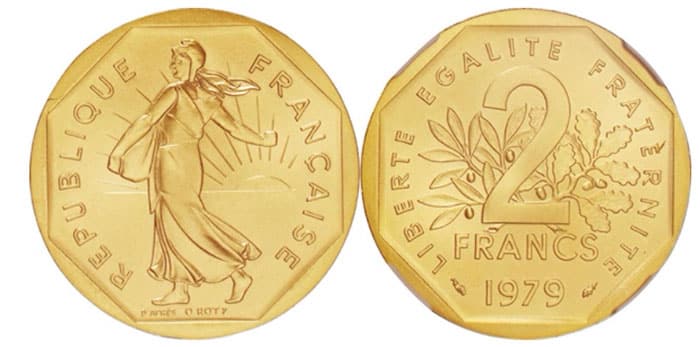
1979 would also see the first year that the FDC sets were packaged in vinyl bi-fold holders.
* * *
About the Author
Tyler Rossi is currently a graduate student at Brandeis University’s Heller School of Social Policy and Management and studies Sustainable International Development and Conflict Resolution. Before graduating from American University in Washington D.C., he worked for Save the Children creating and running international development projects. Recently, Tyler returned to the US from living abroad in the Republic of North Macedonia, where he served as a Peace Corps volunteer for three years. Tyler is an avid numismatist and for over a decade has cultivated a deep interest in pre-modern and ancient coinage from around the world. He is a member of the American Numismatic Association (ANA).




